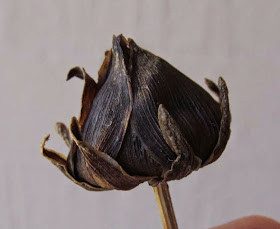One of the amazing things about daisies (Asteraceae) that is hidden to many non-botanists is how they do a lot of things with an inflorescence that other plants do with a solitary flower. To me this appears to be a clear case of convergent evolution: There is a limited number of good solutions to a given problem, and so evolution converges on them over and over again.
As background, most readers will know that what appears to be a daisy "flower" is really a head consisting of numerous small flowers called florets:
The small structures in the middle are the disc florets, some of them in bud, some of them open, and the latter each with five petals and a ring of fused stamens surrounding a forked style in the middle. But, unbelievable as it may sound, the large yellow pseudo-petals around the flower head are also individual flowers. They are called ray florets and are essentially an extreme version of a zygomorphic flower like those found in
Goodenias or
Lobelias, for example; in this case, the three petals forming the lower lip of the flower are massive enlarged while the two petals forming the upper lip are reduced. In many species they also have their own style (although no stamens), further demonstrating their true nature.
Now as I wrote above, daisy heads sometimes converge on the same functionality as individual flowers of other plant groups. The case I noticed recently is
Coreopsis lanceolata. This species, introduced to Australia from North America, has differentiated bracts. The outermost "pretend" to be a calyx, so they have the same role as the outermost, small, green leaf organs of a regular solitary flower and, it has to be said, as the bracts of most other daisies: to protect the developing organ in bud.
However, in
Coreopsis lanceolata there is also an inner group of bracts that are larger and less herbaceous, often already brownish when the head is in flower:
What those inner bracts are good for becomes apparent when the head has finished flowering. The petaloid ray florets fall off, each disc floret starts forming one one-seeded fruit, and at the same time the inner bracts close around the developing fruits to protect them:
When the fruits are fully developed, the inner bracts spread apart again to allow their release. In this way, these bracts behave pretty much like the carpels forming a capsule in many solitary flowers.
Don't know about you, but I find this pretty amazing.













